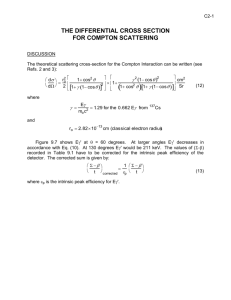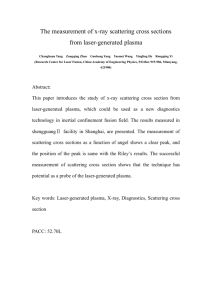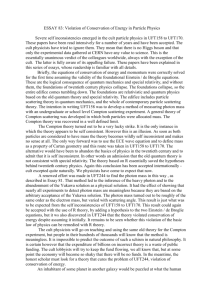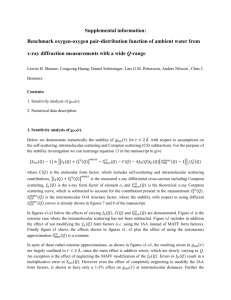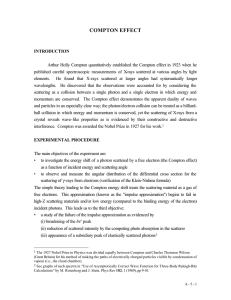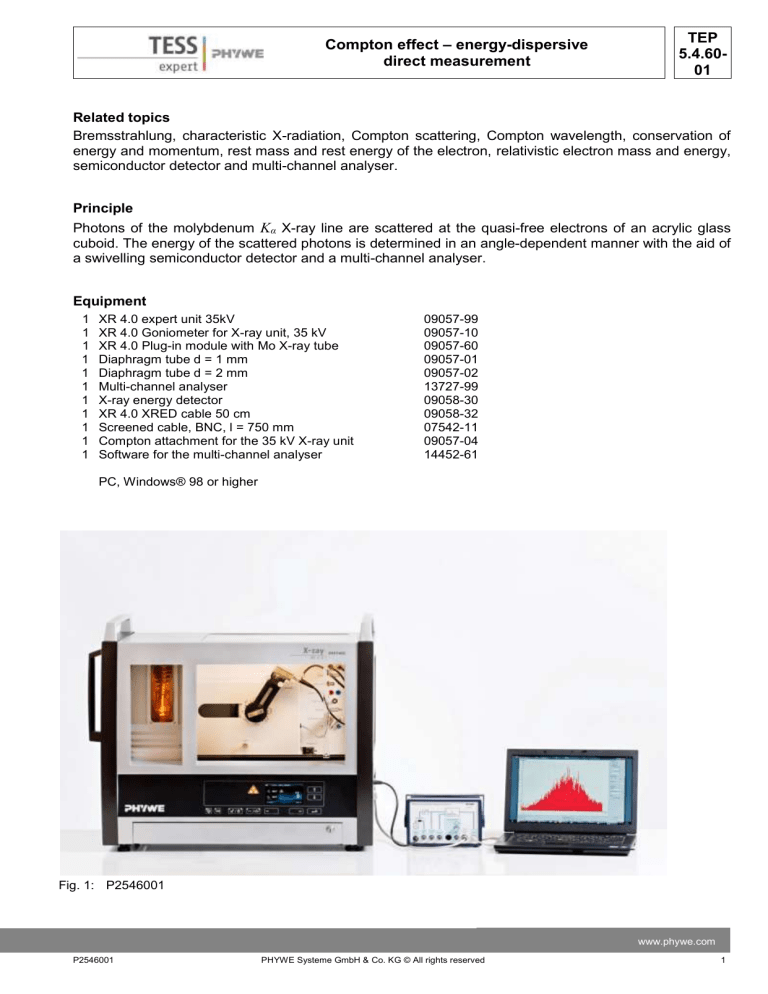
Compton effect – energy-dispersive
direct measurement
TEP
5.4.6001
Related topics
Bremsstrahlung, characteristic X-radiation, Compton scattering, Compton wavelength, conservation of
energy and momentum, rest mass and rest energy of the electron, relativistic electron mass and energy,
semiconductor detector and multi-channel analyser.
Principle
Photons of the molybdenum Kα X-ray line are scattered at the quasi-free electrons of an acrylic glass
cuboid. The energy of the scattered photons is determined in an angle-dependent manner with the aid of
a swivelling semiconductor detector and a multi-channel analyser.
Equipment
1
1
1
1
1
1
1
1
1
1
1
XR 4.0 expert unit 35kV
XR 4.0 Goniometer for X-ray unit, 35 kV
XR 4.0 Plug-in module with Mo X-ray tube
Diaphragm tube d = 1 mm
Diaphragm tube d = 2 mm
Multi-channel analyser
X-ray energy detector
XR 4.0 XRED cable 50 cm
Screened cable, BNC, l = 750 mm
Compton attachment for the 35 kV X-ray unit
Software for the multi-channel analyser
09057-99
09057-10
09057-60
09057-01
09057-02
13727-99
09058-30
09058-32
07542-11
09057-04
14452-61
PC, Windows® 98 or higher
Fig. 1: P2546001
www.phywe.com
P2546001
PHYWE Systeme GmbH & Co. KG © All rights reserved
1
TEP
5.4.6001
Compton effect – energy-dispersive
direct measurement
Tasks
1. Calibrate the semiconductor energy detector
2. Energy determination of the photons of the
W-Lα-line that are scattered through an
acrylic glass element as a function of the
scattering angle.
3. Compare the measured energy values of
the lines of scatter with the calculated energy values.
4. Calculate the Compton wavelength of electrons and a comparison of this value with
the corresponding value of the 90° scattering.
Set-up and procedure
Set-up (Fig. 1)
Fig. 2: Connections in the experimentation area
- Screw the adapter ring onto the inlet tube of
the energy detector.
- Connect the signal and supply cables to the
corresponding ports of the detector with the aid
of the right-angle plugs.
- Connect the signal and supply cables from the
MCA to the appropriate connections in the experiment chamber of the X-ray unit (signal cable: red, supply cable: green (see Fig. 2)).
Fig. 3: Connection at the external panel of the XR 4.0 Xray expert unit to the MCA
right position of the
goniometer
X-ray energy
detector
Compton scatterer
Fig. 4: Set-up at the goniometer
2
PHYWE Systeme GmbH & Co. KG © All rights reserved
P254601
Compton effect – energy-dispersive
direct measurement
-
-
-
TEP
5.4.6001
Connect the external ports for the X RED of the
x-ray unit (signal cable red, supply cable green,
see Fig. 3) to the multi-channel analyse (MCA).
Connect the signal cable via a screened BNCcable to the “Input” port of the MCA and the
supply cable to the “X-Ray Energy Det.” port of
the MCA.
Secure the energy detector in the holder of the
swivel arm of the goniometer. Lay the two cables with sufficient length so that the goniometer can be swivelled freely over the entire swivelling range.
Connect the multi-channel analyser and com- Fig. 5: calibration of the multi-channel analyser
puter with the aid of the USB cable.
Insert the tube with the 2-mm-aperture.
Bring the goniometer block and the detector to their respective end positions on the right.
Calibration of the multi-channel analyser
(if there is no other already existing calibration that can be used)
- Bring the goniometer block and the detector to their respective end positions on the right.
- Insert the tube with the 1mm-aperture into the exit tube of the X-ray tube.
- With the X-ray unit switched on and the door locked, bring the detector to the 0° position. Then, shift
the detector by some tenths degree out of the zero position in order to reduce the total rate.
- Operating data of the tungsten X-ray tube: Select an anode voltage UA = 25 kV and an anode current
IA = 0.02 mA and confirm these values by pressing the “Enter” button.
- Switch on the X-radiation
- In the MEASURE program, select “Multi channel analyser” under “Gauge”. Then, select “Settings and
calibration”. After the “Calibrate” button has been clicked, a spectrum can be measured. The counting rate should be < 300 c/s. Energy calibration settings: - 2-point calibration, - Unit = keV, Gain = 2 –
Set the offset so that low-energy noise signals will be suppressed (usually a few per cent are sufficient), See Fig 5.
- Measuring time: 5 minutes. Use the timer of the X-ray unit.
- Make the two coloured calibration lines congruent with the line centres of the two characteristic X-ray
lines. The corresponding energy values (see e.g. P2544701) E(L3M5/L3M4) = 8,41keV and E(L2N4) =
9,69 keV are entered into the corresponding fields, depending on the colour. (Note: Since a separation of the lines L3M5 and L3M4 Lines is not possible, the mean value of both lines is entered as the
energy of the line).
- Name and save the calibration.
Compton scattering
Set the detector to the zero position and select the following operating data: diaphragm tube with d = 1
mm, UA = 30 kV, IA = 0,08 mA.
- Enter the following parameters into the field “Control” in the window “Spectra recording”: - Gain = 2, –
Offset = 5%, - X-Data = keV, - Interval width [channels] = 1.
- Start the X-ray tube. The measuring time should be approximately 5 minute so that the intensity of
the Kα-peak is approximately 200-300 pulses. Accept the data and save them.
- Place the acrylic glass element (scatterer) of the Compton equipment into the sample holder and set
www.phywe.com
P2546001
PHYWE Systeme GmbH & Co. KG © All rights reserved
3
TEP
5.4.6001
-
Compton effect – energy-dispersive
direct measurement
it to a 10° position. Set the detector to 20°.
Now, add the tube with the 5 mm aperture and increase the operating data of the X-ray tube to UA =
30 kV and IA = 0.3 mA.
Start the measurement. The measuring time is approximately 10 minutes. The intensity of the Kαpeak should be approximately 200 pulses. Stop the measurement with “Accept data”.
Leave the acrylic glass scatterer in its position and perform additional measurements. To do so,
change the angle of the detector in steps of 10° up to the final value of 160°.
Evaluation of the measurement curves
- In order to determine the line energy, switch from the bar display to the curve display. To do so, click
“Display options” and then “Interpolation and straight lines”.
- Extend the relevant line section with the aid of the zoom function .
-
Then, select the curve section with
. Open the window “Function fitting
normal distribution”.
Find the line centroid of the normal distribution
with “Peak analysis
“ or determine it with the
function “Survey
“.
Theory and Evaluation
Figure 6 shows a schematic representation of the
Compton Effect.
Due to the interaction with a free electron in the solid element, the incident photon loses energy and is
deflected from its original direction with the scattering angle ϑ. The previously resting electron absorbs
additional kinetic energy and leaves the collision
Fig. 6
point under the angle φ.
E2
”. Then, select “Scaled
Momentum and energy relation of the Compton
effect
E1
(1)
E
1 1 2 1 cos
m0 c
Photon energy before and after the collision E1 bzw.E2
1 eV = 1.6021・10-19 J
Equivalent
Scattering angle
ϑ
c = 2.998∙108 ms-1
m0 = 9.109∙10-31 kg
Speed of light in vacuum
Rest mass of the electron
After the collision, the photon has a lower energy level E2 and a higher wavelength λ2.
With E = hν, (1) can be transformed into:
1
h 2
1
1
1 cos
h 1 m0 c 2
(2)
Planck’s quantum of action h = 6.626∙10-34 Js
Photon frequency
ν
4
PHYWE Systeme GmbH & Co. KG © All rights reserved
P254601
TEP
5.4.6001
Compton effect – energy-dispersive
direct measurement
With λ = c/ν (2) leads to:
2 1
h
1 cos
m0 c
(3)
For the 90° scattering, the difference in wavelength, which only consists of the three universal components, provides the so-called Compton wavelength λC for electrons.
C
h
6,626 10 34
Js
2,426 pm
31
8
m0 c 9,109 10 2,998 10 kg ms 1
As far as the special cases of the forward and backward scattering by ϑ = 0° and ϑ = 180° are concerned, the change in wavelength is Δλ = 2λC..
Task 2: Energy determination of the photons of the W-Lα-line that are scattered through an acrylic glass
element as a function of the scattering angle.
Figure 7 shows a part of the X-ray spectrum of molybdenum. For the angle-dependent displacement of
energy of the scattered radiation, only the high-intensity Lα-line is to be taken into consideration.
Figure 8 shows the tungsten-Lα-Line of various scattering angles ϑ.
Task 3: Compare the measured energy values of the lines of scatter with the calculated energy values.
Column B of table 1 shows the experimental energy values of the line peaks of the W-Lα-line as a function of the scattering angle (column A).
Fig. 7
X-ray spectrum of tungsten (section)
www.phywe.com
P2546001
PHYWE Systeme GmbH & Co. KG © All rights reserved
5
TEP
5.4.6001
Compton effect – energy-dispersive
direct measurement
For comparison, the column C shows the energy values
that were calculated with E1 (Mo-Kα) =17.43 keV based
on (1).
Figure 8 shows the content of table 1 in graphical form
for clarification.
Figure 9 shows examples of the spectra of the Mo-Kαline in a small energy interval for various scattering angles (the line at ϑ = 0° is the unscattered Kα-line). It
shows that the energy of the scattered radiation decreases when the scattering angle increases. In addition, one can see that the 90° scattering leads to the
lowest scattered intensity.
Table 1: Energy E2 of the scattered photons as a function of the scattering angle ϑ
A
ϑ/°
20
30
40
50
60
70
80
90
100
110
120
130
140
150
160
B
E2 (exp.)/ keV
17,39
17,36
17,32
17,24
17,15
17,06
16,95
16,85
16,75
16,64
16,55
16,50
16,44
16,40
16,32
Fig. 8: Energy of the molybdenum Kα-line as a function
of the scattering angle.
Extended curve: calculated with E1 = 17.43 keV
and equation (1)
• = measurement value of column B of the table
C
E2 (theor.)/ keV
17,394
17,350
17,290
17,218
17,134
17,043
16,947
16,849
16,752
16,659
16,572
16,495
16,429
16,376
16,337
Task 4: Calculate the Compton wavelength of electrons and a comparison of this value with the corresponding value of the 90° scattering.
In order to determine the Compton wavelength λC based on the 90° scattering, equation (3) is transformed with λ = h · c/E:
1
1
E2 E1
C 2 1 h c
(4)
With E2 (90°) = 16.64 keV (see table) and E1 (0°) = 17.43 keV and the equivalence 1eV = 1.602 · 10-19 J,
one obtains the following Compton wavelength based on the experiment:
C 2,49 pm
6
PHYWE Systeme GmbH & Co. KG © All rights reserved
P254601
TEP
5.4.6001
Compton effect – energy-dispersive
direct measurement
Fig. 9: Molybdenum-Kα-Line of various scattering angles ϑ
Appendix
Conservation of momentum:
p1 p 2 pe pe2 p12 p 22 2 p1 p 2
(5)
The following applies to the angle ϑ that is formed by the two momentum vectors p1 and p2:
p1 p 2
cos
(6)
p12 p 22
With (6) and the momentum-energy realtions p1 = E1/c and p2 = E2/c (momentum-energy relation based
on a combination of E = hν; the photon momentum p = h/λ (de Broglie) and c = λν), equation (5) leads to:
p e2
1 2
E1 E 22 2 E1 E 2 cos
2
c
(7)
Conservation of energy:
If one takes the relativistic effects for an electron with the velocity v into consideration, the following results:
E1 m0 c 2 E 2 E e E 2
m0 c 2
1 v2 / c2
(8)
With Ee = mc2 and pe = mv it follows:
www.phywe.com
P2546001
PHYWE Systeme GmbH & Co. KG © All rights reserved
7
TEP
5.4.6001
Compton effect – energy-dispersive
direct measurement
v2
c 4 pe2
Ee2
(9)
If one puts (9) into (8), the following results:
p e2
1 2
E1 E 22 2m0 c 2 E1 E 2 2 E1 E 2
2
c
(10)
The combination of (7) and (10) leads to the following for E2:
E2
8
E1
1
E1
1 cos
m0 c 2
PHYWE Systeme GmbH & Co. KG © All rights reserved
P254601


